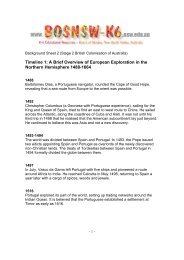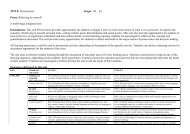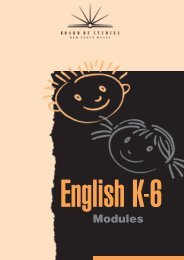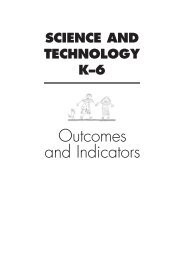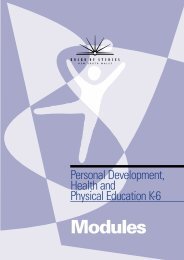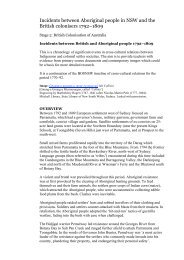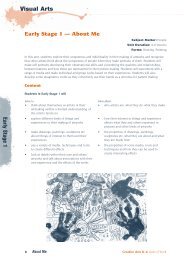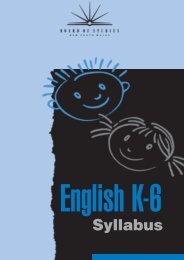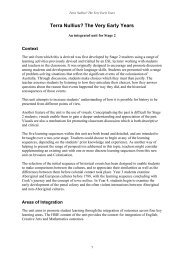Math K-6 WS - K-6 Educational Resources
Math K-6 WS - K-6 Educational Resources
Math K-6 WS - K-6 Educational Resources
You also want an ePaper? Increase the reach of your titles
YUMPU automatically turns print PDFs into web optimized ePapers that Google loves.
<strong>Math</strong>ematicsK-6<br />
2.3 Planning units of work for effective<br />
learning and assessment<br />
The syllabus acknowledges that students learn in different ways and at different rates. Teachers therefore may need<br />
to incorporate a range of activities to accommodate the different ways students learn and to cater for the range of<br />
levels of students’ current knowledge, skills and understanding in mathematics. In Year 3, for example, while there<br />
may be a majority of students working within Stage 2 content, other students may be working within Stage 1, or<br />
perhaps within Early Stage 1 or Stage 3.<br />
The syllabus reflects the hierarchical nature of most learning in mathematics. New learning builds upon prior learning<br />
in the same, or a related, substrand from the syllabus. In this way, it is possible that students may have met content<br />
related to the unit of work previously. If the targeted outcomes have been partially achieved, the unit should focus on<br />
consolidating and extending the student’s knowledge, skills and understanding.<br />
Teachers can program for related topics from different Stages to be taught sequentially or concurrently in a particular<br />
Year. For a small school or multi-grade class, the teacher may decide to teach a unit on Two-dimensional Space using<br />
Polygons as the focus. The teacher may set up teaching/learning situations where each Stage would use shapes<br />
applicable to the content in their Stage. For example:<br />
■ Early Stage 1 students would look at squares, rectangles and triangles<br />
■ Stage 1 students would also look at hexagons, rhombuses and trapeziums<br />
■ Stage 2 students would also look at pentagons, octagons and parallelograms<br />
■ Stage 3 students would also look at isosceles, equilateral and scalene triangles.<br />
The activities could include open-ended tasks such as students organising a presentation about their polygons, Barrier<br />
Games, constructing a picture using the shapes, and the use of computer drawing programs to draw their shapes and<br />
make pictures, patterns or tessellations.<br />
Substrands from different strands may be integrated, for example, Chance and Data. Appropriate learning experiences<br />
could be:<br />
■ Stage 1 students might pose the question ‘What rubbish will we find in the playground after<br />
lunch?’ Students make predictions, and then visit the playground to collect data. The data can<br />
then be organised into a data display.<br />
■ Stage 2 students might conduct simple experiments with random generators such as coins, dice or<br />
spinners to inform discussion about the likelihood of outcomes. For example, students roll a die<br />
fifty times, keep a tally and graph the results.<br />
■ Stage 3 students might use samples to make predictions about a larger ‘population’ from which the<br />
sample comes eg predicting the proportion of cubes of each colour in a bag after taking out a sample<br />
of the cubes. Students could graph predictions and the results of the draw and compare.<br />
The Patterns and Algebra and Number strands could be programmed together to enable students to make important<br />
links between number patterns and relationships and the four operations.<br />
6



